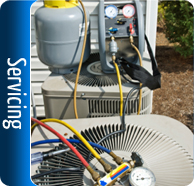R32
When domestic air conditioners using R32 were launched in Japan in 2011 the launch was accompanied by a training programme for installers, designers and specifiers covering the properties of the refrigerant, plus handling, installation and servicing procedures. It should be noted that there are now in excess of 4 million units sold in Japan that use R32.
This approach has been adopted in the UK as it prepares to introduce its first split systems with a cooling capacity under 7kW using R32 this year. In April 2015 the first of a series of training seminars will be rolled out at training centres across the UK.
The primary aim is to ensure installers are well informed, confident and competent in installing and maintaining systems using R32 as well as being aware of any safety and compliance issues.
As R32 makes up 50 per cent of R410A, the changes to installation procedures are relatively minor. In essence, installation is the same, the pipe work is the same (using flared connections) and pressure testing and leak testing are the same.
Different tools are needed, which should be rated for use with R32 but will also be able to be used with R410A as well. These tools – including gauges, manifolds, leak detectors and flameproof recovery systems – are already available.
R32 Concerns
Concerns have been raised over the use of R32 with regard to its flammability and toxicity and the risks during transporting, handling, installation and maintenance.
Like most low-GWP gases, R32 is flammable given the right set of conditions. However, it is rated as A2L (ISO 5149). This means there is a low risk of accidents due to toxicity (A) and it is mildly flammable (2L), i.e. it requires more than 100g/m3 to burn (typically 300g/m3) and has a burning velocity of less than 10cm/s.
R32 has a burning velocity of 6.7cm/s, compared with propane’s burning velocity of 46cm/s. Tests have shown that, even if combustion of R32 occurs (at concentrations of more than 320g/m3) it is not explosive and the possibility of fire spreading is extremely low.
In fact, in the unlikely event that the entire R32 charge from a domestic air conditioner leaked into a room, its concentration would be so low that there would be no possibility of combustion. Furthermore, ignition does not usually occur from the type of electrical capacity used in household switches.
Equally when performing soldering work during maintenance activity, a flame will blow out naturally and not continue to burn because the flow of leaking refrigerant is faster than the speed that transmits combustion. However, it should not be ignored that installers will be handling a flammable gas. This means a new set of charging and recovery procedures need to be followed but nothing that will present a major challenge.
An R32 system must be ventilated during charging and recovery to prevent build-up of refrigerant which could then be ignited by a naked flame. Ordinarily this is not an issue but if an outdoor unit is being installed in an enclosed area, then a flameproof fan should be used to ventilate the area while charging is being carried out.
It’s worth remembering that this approach is also recommended when installing systems with R410A as the R32 component of R410A gases could separate and as a result could be flammable.
When it comes to transporting R32 the same precautions need to be taken with acetylene that is used for brazing apply: there should be adequate and permanent ventilation through the vehicle (as R32 is heavier than air) and no smoking to reduce the risk of ignition. There have also been concerns over the potential for the creation of hydrogen fluoride if R32 is ignited. If exposed to high temperatures (for example an oxy-acetylene flame), R32 will decompose into three substances: carbon monoxide, carbon dioxide and hydrogen fluoride. The latter when mixed with water creates hydrofluoric acid which is highly toxic.
However, all HFC refrigerants including those commonly used today will undergo this process on exposure to high temperatures, so while the risks cannot be ignored they highlight the importance of safe working practices, regardless of the refrigerant being used.
The introduction of R32 will present some challenges for industry, however while installation and safe handling procedures will have to change, they are not too dissimilar to those already being used for R410A. What will not change is the imperative that HVAC-R equipment is installed and charged by competent and well trained people.





